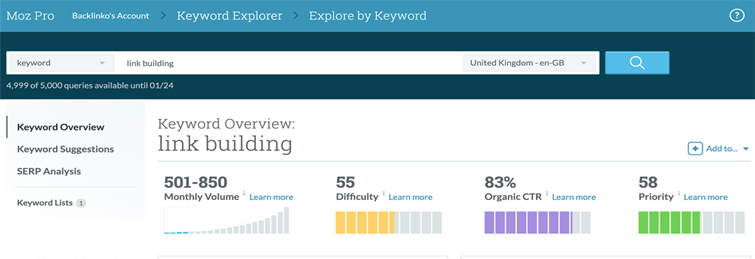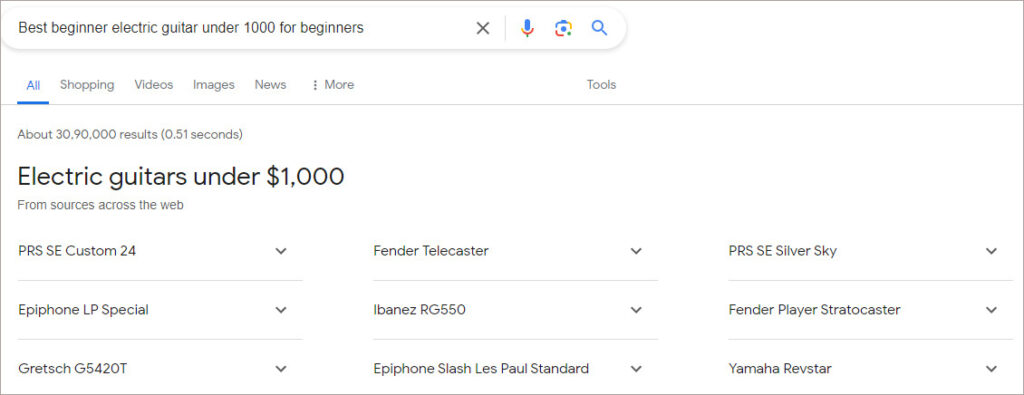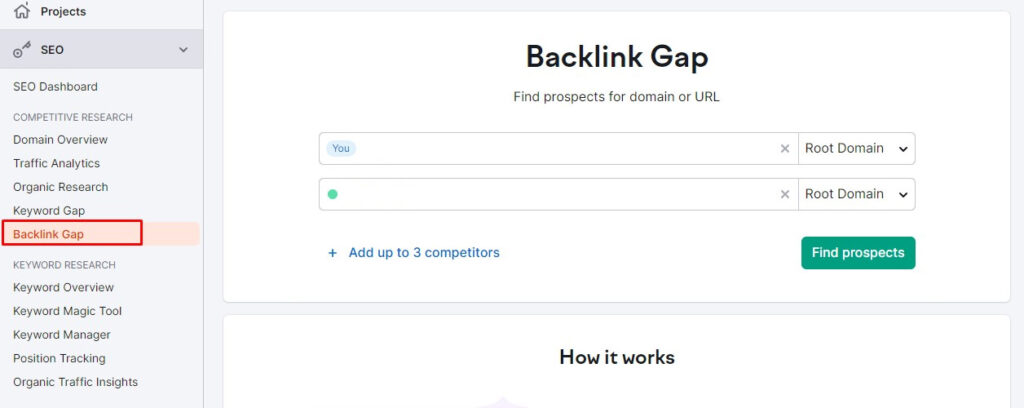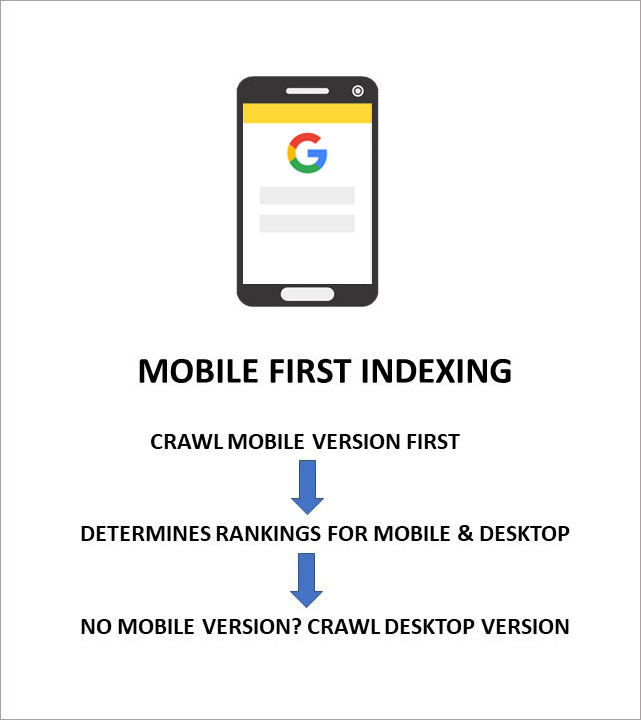Even if you work hard on your website and make good content, there’s no guarantee that people will see it. In the end, other companies trying to rank higher in search engines might be using similar strategies. Possibly even better than you.
How can you beat your competition? That’s where SEO competitor analysis is useful. By looking at what your competitors are doing with their SEO, you can figure out what is working well for them and why their content is successful.
When you do SEO competitor analysis, you can compare two websites and see their important metrics. Based on that, you can adjust your plan to have an advantage over them. In this post, we will explain how to do competitor analysis, mistakes to avoid, and when you must do it.
What Does SEO Competitor Analysis Mean?
SEO competitor analysis is when you look at what your competitors are doing online. You check out their keywords, links, and content to see what they’re good at and what they’re not so good at.
By analyzing your SEO competitors, you can see how you compare and improve your ranking in search results. By learning from what your competitors are doing well, you can use those ideas to make a strong SEO plan for your business.
Why is it Important to Do SEO Competitor Analysis?
Here are some reasons why analyzing your competition for SEO can help you.
Find Strengths and Weaknesses
Find out what your competitors are good at and where they are not doing well in terms of their online presence through SEO competitor analysis. It shows ways to choose the right keywords, create good content, get other websites to link to yours, and use good technical SEO. By knowing what competitors are good at and where they need to improve, businesses can find ways to do better and take advantage of chances to be more competitive.
Create a Strong Strategy
Studying your competitors can help you create a strong plan for getting more people to visit your website. Businesses can learn from what other companies do well, and use that information to improve how they operate. This can help them decide what to focus on and how to use their resources wisely. This involves making choices about which keywords to focus on, creating content, building links, and making technical improvements.
Find New Opportunities
Looking at what other companies are doing helps you find new ways to succeed in the market. Businesses can succeed by finding where their competitors are not doing well. Then, they can take advantage of these chances to stand out, find unique ways to sell their products, or focus on specific keywords. This helps businesses stand out from other competitors and make a unique place for themselves in the market.
Compare Performance
Businesses can check things like website visitors, how well their keywords show up in searches, and the websites that link back to them. This helps them see how they’re doing compared to other businesses and figure out what they can do better. This helps you make achievable goals, keep an eye on how you’re doing, and see how well you’ve done, which gives you helpful ideas for making things better.
Beat the Competition
Studying competitors helps businesses learn about what’s happening in their industry, new competitors that are coming up, and changes in how search engines work. By watching what other businesses are doing and how well they are doing, businesses can change their SEO plan, find new chances, and lower risks. This helps businesses stay ahead of their competitors and do well in the long run in their markets.
When Should SEO Competitor Analysis be Done?
You need to regularly check what your competitors are doing with SEO to stay ahead and improve your search ranking. Here are some important times when businesses should check what their competition is doing with their website and online marketing.
When You are Introducing a New Product or Service
You should study the keywords that your competitors are using to reach customers and look at their content plan. At this point, you should concentrate on finding:
- Popular words people use to find your product or service on the internet
- The best pages for the chosen keywords
- Keywords that are important for your product or service that are missing
- Study the information on the first few pages of search results and examine the strategies used for creating that content
Studying your competitors’ SEO strategies can help you create a better marketing plan for your new product or service.
When You Want to Rank Up in Search Results
If you want to rank higher in searches, you need to figure out what is making your competitors rank higher. Right now, you need to concentrate on finding and studying:
- Keywords used by your competition
- Backlinks from competitors
- The quality of the content for content that is ranked at the top
By studying your competition’s SEO strategies, you can learn what they are doing well and what you can do better.
When the Industry or Market Has a Major Shift
Keep an eye on competitors’ websites to see if their SEO strategies and tactics have also changed. At this point, you should concentrate on finding:
- Changes in how often keywords show up in search results
- Changes in how much people are interested and how many visit the website
- Finding new words to use
- Fresh chances to create new links
By checking the search engine results, you can change your SEO and content plan to beat the competition.
Every Three Months
Every quarter you need to compare your SEO with your competitors so that you can keep up with them.
For this SEO competitor analysis, you should look at and study how your competitors are using different keywords, the content they are sharing, and the websites that are linking back to them.
What Factors to Consider for SEO Competitor Analysis?
Analyzing SEO competition takes a lot of work. When you study the information about companies similar to yours, here are some things you should consider:
Keywords: Pay attention to the words your competitors are focusing on and ranking for. Study how many people search for those words and how hard it is to rank for them.
Content Topics: See what kinds of things your competitors are writing about. Examine the words they use and what kind of search they meet.
Blog Posts: Make sure to look at the titles, sub-titles, and information in the content from other websites that are trying to rank high on search engines. Compare it with what you have and figure out if it’s better than yours.
Backlink Profile: Find out which websites link to your SEO competitors and how strong they are in terms of their website authority. Check if you can also get backlinks from the same places.
Social Media: Find what your competitors are doing on social media and see how they use different platforms. Then, figure out what their strategy is.
Technical SEO: Look at your competitors’ website speed, broken links, URL structure, and other important factors that affect how well your website performs in search engine results.
How to Perform SEO Competitor Analysis?
If you want to check out how your website compares to others in search engines, here’s a simple guide to help you do it step by step.
Find Out Your SEO Competitors
When you do SEO competitive analysis, it’s important to know your competitors and what they are good at and what they are not good at. By doing this, you can find ways to be better than your competition and make your website show up more in search results.
First, you need to write down the names of the other companies that you compete with. You might already know the big companies that sell similar things, have the same customers, and charge similar prices.
However, these rivals may not be the ones that you are competing with for SEO. Your SEO competitors are the companies in your industry that appear on the first page of search results when people search for the same keywords as you.
How to Identify Your SEO Competitors?
There are a few ways to find out who your SEO competition is. Even if you are new to SEO, you can do it yourself without any trouble.
Do a Google Search
For instance, if you have a travel agency in Baltimore, some good long keywords to focus on would be “best travel agents in Baltimore”. If you search on Google, you can find a list of the best websites for it. These are the websites that you need to compete with in search engine rankings.

To find all the important words, you should check different types of keywords and see the search results. Remember that it will be hard to compete with large agencies to be at the top of the first page in a search engine.
This is very true if you are just starting a new site with low DA. If your business does different things or offers different services, you should check on your competitors for each thing or service.
Use SEO Tools
Another way to study the competition is by using keyword research tools such as Semrush. This is one of the top SEO audit tools available. You can also use it to find keywords and analyze your competitors. By studying your rivals, you can find words that aren’t as hard to rank for.
With Semrush, you can learn more about who your SEO competition is and what strategies are helping them succeed. With this information, you can improve your content plan. Before you start making content, we suggest you look carefully at the search results for your field.
If other websites are showing up before yours on search engines when people search for a certain word, you might want to make a video so you can compete with them. To do more, you can make a long article and put the video in it.
Make a List of Important Keywords to Target
When analyzing SEO competition, some keywords are more important than others. During keyword research, you look for words that lots of people search for and are related to your industry or business.
The best way to find important keywords is to use a tool to see what keywords your competitors are using for SEO. In Semrush, under “Competitive Research”, you can find the “Organic Research” option.

You can choose a few companies that do similar things to you and save their list of keywords. This can help you find words that are important for your business. You can use this data smartly to choose important keywords that can help you make the most money.
Search for Long-Tail Keywords
If your website is not well known, it can be scary to see big websites ranking at the top of search results. To appear at the top of search results, you can use long and specific keywords instead of popular ones.
For example, it is very hard to rank for the word “shoes”. If you want to be different and get noticed, you have to use very exact words when you search. Consider words such as “men’s casual shoes”.

When you are doing SEO competitive analysis, make sure to look for long and specific keywords that are not used by too many websites. Although not many people search for long-tail keywords, they bring in more of the right kind of visitors. Also, it will be easier to beat your SEO competitors with less effort.
Find Keyword Gaps
Starting from scratch to rank for a keyword might take a long time. However, this is not true for the words that your website is already ranking for. Let us assume, your website is at number six on the first page of Google and your main competitor is at number two.
It will be easier to surpass them by finding keyword gaps than to write an article with good SEO and wait for it to rank higher. For those who don’t know, keyword gap analysis is about comparing and finding the differences in the keywords that are being used by different websites.
By comparing keywords, you can find out which ones your SEO competitors are doing well with and which ones you have a chance to beat them in. This process helps you see which words are bringing people to your website and your competitors’ websites.
Keyword gap analysis can help you understand where your website is lacking in important keywords compared to your competitors. It can help you to:
- Find keywords to focus on
- Find more keywords to make your content better
- Discover fresh topics for your content
- Learn about what your competitors are good at
- Know what your audience wants and what they are interested in
By analyzing the keywords used by competing websites, your content and SEO team can discover which keywords can bring in the most visitors to your site. From there, you can make a list of the most important keywords to focus on.
How to Find Keyword Gap for a Site?
To see which keywords you and your competitors both rank for, you can use special tools for keyword gap analysis. Tools like Semrush, Link Assistant, and Similarweb allow you to find keywords that are missing from your website.

For example, if we were in charge of Nike’s website, we would look for information to answer these questions:
- Why is Adidas appearing in search results for some keywords?
- What content does Adidas have for these keywords?
- Is Adidas getting ranked higher because they have a lot of other websites linking to their page?
- How can we focus on the listed keywords?
In our opinion, if you answer these questions, you will find the most important keywords to focus on. You will also understand how likely it is for you to rank for these keywords. To understand the competition in SEO better, you can compare keywords used by different SEO competitors at the same time.
Evaluate Shortlisted Keywords’ Difficulty
To be honest, you can theoretically outrank any of your SEO competitors in any industry or niche. But it’s not possible. You might not have enough resources or time to focus on getting ranked for your most important keywords.
For whatever reason, it might not be possible for you to focus on specific keywords. That’s why you should check how hard your chosen keywords are. This needs a careful plan and should have several steps to make sure it’s correct.
First, you need to look at the search engines to see what SEO tactics your competition is using. This means looking at many things such as:
- Domain Country
- Domain Authority
- Domain Age
- Backlink Data
- Traffic Volume
- Catalog Listings
Next, find out how difficult each keyword is. You can use different tools like Moz, Semrush, or Ahrefs to see how hard specific keywords are to rank for.

Let us assume your target keyword is “walking shoes for men”. To quickly check how hard a keyword is, you can type it into Moz’s Keyword Explorer Tool’s search bar. When you click on “Analyze,” Moz shows you how hard a keyword is to rank for, how often it’s searched for, how many people click on it in search results, and how important it is.
Moz uses the Domain Authority and the Page Authority to calculate the score for the websites listed on the first page of Google. Scoring 0 to 50 is seen as easy to beat, but anything over 60 is hard. Small websites find it hard to rank for keywords with a difficulty score of 40 or higher.
Monitor Keyword Rankings for a Period of Time
After checking how hard it is to rank for certain keywords in SEO, it’s important to keep an eye on how your rankings for those keywords change over time. This can help you find chances for success. You will find out how you compare to your competitors and what type of content to post.
You can keep track of how well your keywords are ranking using tools like Sitechecker, Serpstat, and Wincher. These tools help you see if your keywords are ranking higher or lower and show you how your SEO campaign is doing. We will see how to keep track of your keyword rankings using Sitechecker.

Step 1: Sign in to Sitechecker’s Rank Tracker and adjust the settings in Project Editing. Before you can add keywords, you need to add your search engine, language, city, device, and searcher domain.
Step 2: Enter the words you want to keep track of where your website shows up in search results. You can either type the keywords or use the “Suggest Keywords” option if you’ve linked your account to Google Search Console.
Step 3: After you put in the keywords, the tool will begin to gather useful information for your results. This can take a long time. You will see the first results in a few hours. Once you set it up, your information gets updated on its own every day. The first chart will let you see the general pattern of the keywords you entered. When you move the page down, you can also see the words and how they move every day.
Step 4: To see a more detailed look at the keyword changes, switch to the “Advanced” view from the top-right corner. You can also choose which numbers you want to put on your chart by clicking on the columns. You can save this information as a .pdf file or a .csv file.
Examine Search Engine Results
Studying what content your competitors have that ranks well can help you figure out what your target audience is looking for when they search. By checking which words are used most, you can figure out what the readers want and what kind of articles they like.
Search intent means the main reason why someone looks for something on the internet.

When we talk about SEO, search queries can be grouped into four main types of intent:
- Navigational
- Informational
- Transactional
- Commercial
Now, we will look at each of the four search intents in detail. It is of utmost importance to know the search intent of the user before creating relevant content for it.
Informational Search Intent
When someone is looking for information on a topic, they want to find as much useful information as they can. They might want to see the newest weather news or learn how to repair their car.

It is important to know that Google understands searches more than just the words used.
For example, Google knows that most people looking for “homemade snacks” want to find recipes to make at home.
That’s why the search results have a special post that matches what you’re looking for. Content that provides information for people who are looking for answers or solutions to their questions:
- Long blog posts
- Educational articles
- Tutorial videos
- How-to blogs
When you write posts for this search intent, focus on giving helpful information and explaining a concept, tool, or feature. You can include links to products that match the topic of the post. But be careful not to sound pushy or fake in the context of the topic.
Navigational Search Intent
People who search for this usually want to find and go to a specific website or page. They might look for a company’s name to find its website and other details. When someone looks up “Facebook”, they probably want to go to the app. That is an example of searching for directions or locations.

Google knows what the user is looking for. That’s why the first thing you would see is Facebook’s homepage. For this kind of search, you need to make sure that people can find your business easily on the internet.
When people look for your business on Google, they should be able to easily find your website and how to contact you. Just remember, you will only get more visitors to your website if people are looking for your business. Content that helps this type of search intent:
- Home page
- Landing page
When making content for a specific search topic, use the important words that are related to your specific area, business, and industry.
People who come to your website looking for specific information may not know much about your business. To improve your ranking and get more people to visit your website, you need to write short and clear text that explains what your business does.
Commercial Search Intent
Some people want to buy something, but they want to check it out on the internet first. These users are willing to spend money, but they are looking at different choices, researching information, and comparing prices.
For example, if a person is looking at different electric guitars that are priced within a certain budget, the featured snippet would list the best 8 choices to help the user find the information they need easily.

Words like “Under $500” or “offer” show that the person is looking to buy something. An article that compares different choices can meet what the user is looking for. Content that is designed to attract people who are looking to buy something:
- Reviews
- Listicles
When writing for this type of search intent, make sure to write about everything that helps people decide to buy it. You can put links to buy things to change some people visiting your site into customers who will pay for your products.
Transactional Search Intent
People who want to buy something online come under transactional search intent users. They know what they need and what choices they have. After doing research, they have chosen their favorite and want to buy it now.

Generally, in the search results, the pages at the top all go to the product page. For these search questions, Google may show a highlighted answer at the top of the search results.
Content that is designed to provide information for people want to make a purchase:
- Product Pages
- Reviews
Different search intentions need different content to meet the reader’s needs. Someone looking for the best mobile phone won’t be interested in reading about the history of mobile phones.
They want to find out which phones they can buy and where they can get the best price.
By understanding what people are looking for when they search and which articles are popular in the search results, you can make content that suits their needs better.
Make sure to carefully examine what your competitors are trying to achieve with their posts. With that information, you can make your SEO content strategy better.
Also Read: SEO Best Practices: How to Rank Higher in Search Engines on Google
Perform a Technical SEO Audit
Analyzing your competitors’ websites for technical SEO can help you find out what they are good at and what they are not so good at. This can help you make a plan to do better than them in search engine rankings. When you check out your competitors’ websites for SEO, here’s what to look for:
Website Speed: Analyze how fast the website loads and figure out what is making it load slowly.
Mobile-Friendliness: Check if the website works well on phones and tablets.
Crawlability: Check if search engines can read and index all the pages on the site.
Website Structure: Look at how the website is organized, including the web addresses, how pages link to each other, and the site map.
Technical Issues: Look for any mistakes with the website, like broken links, pages that can’t be found, or problems with the server.
Security: Check if the website has an SSL certificate and is set up for safe browsing.
On-Page SEO: Making sure your website is on-page optimized for search engines is important because it helps them to better understand and find your content. On-page optimization includes things like:
Meta Description: Look at how your competition is writing their meta description tags. The meta description tag is like a summary that tells people what the page is about and why they should look at it. Check for keywords, a call to action, and how simple it is.

Google’s search engine bots may not always use the description that’s added in the meta description tag. However, they do use the tag to make highlighted pieces of information.
Titles: Check the title of the web pages that you shortlist. Make sure the title tag matches the title. Remember that Google might change the title of the website to show the site name or an important word. Sometimes you might not see the exact words you were looking for in the title. That’s why you should look at both when you check your competitor’s websites.

Structure of URL: A clear and organized website address can help Google to understand how your website is set up. When you look at other websites, check the words and categories they use in their web address. If you want to beat a competitor in search results, you need to check their website’s URL structure to see how it’s organized.

<h> Tags: Google looks at <h> tags to understand what the content on a web page is about. Also, they make the content easier to read. Google crawlers can also use tags to collect information for featured snippets. When looking at other companies’ websites, see how they use tags to categorize different parts of an article.

Study Your Competitors’ Best Web Pages
After finding popular search terms and studying what shows up in search results, you should learn more about what kind of content your competitors are doing well with in terms of SEO.
You want to find the content of your competitors that got the most links. Getting good backlinks is really important for ranking well on Google. If you want to do better than your competition, you need to find out where they are getting the most links from.
All the big SEO tools can check backlinks, but we prefer using Moz because it’s easy and doesn’t cost anything. Here is how to see which pages have the most backlinks using Moz’s Link Explorer tool.
Step 1: Type the website address into the search box in Link Explorer to see the top pages.

Step 2: Look at the “Top Pages on this Site” section. Focus on the pages with the highest page authority.
Step 3: If you want more detailed information, you can click on the section to see an overview. You can arrange the list by page Authority by setting the status code to “200-OK”.
You can save this information to a .csv file to look at it later. After you receive the list, click on the website links to see what’s on them. Be sure to focus on the subject and how the information is presented.
You can make the existing content better by using that information. Here are some tips to help you make your content better than other people’s:
- Split your content into different smaller topics
- Add smaller topics under H2 and H3 headings
- Make your content easier to read by including bullet points
- Include pictures, videos, GIFs, and other media
- Ask industry leaders for their opinions
- Use accurate statistics
- Provide answers to common questions about the subject
Analyze the Links of Your Competitors
Competitor link analysis helps you find websites and web pages that link to your competitors but not to your own website. This information can help you find and get good links more easily. These links are easier to get because:
- They have already shown that they are interested in your type of business
- They have posted content about the keywords you are focusing on
You can ask these sources for links by showing them that you can offer better content than your competitors. In our opinion, using this strategy improves your chances of getting a link.
How to Do Link Analysis Using Semrush?
Before you check for missing links, it’s a good idea to review the links pointing to your website. That way, you can see what backlinks you have. Next, you need to find websites that link to your competitors but don’t link to your site. Here is how to analyze the links on your website using Semrush:
Step 1: Use the “Backlink Gap” tool on Semrush and type in the domain names you want to compare.

Step 2: Look at the table and graphs to compare the competitors’ backlink profiles. The trend graph helps you see which competitor has the most backlinks.

Step 3: Go down to see the websites that send links to the domain names you entered. The tool is set to “You-Domain” by default. That means you will find websites where you can ask for a link to your site.

You can focus on these websites to get the same backlinks as your competitors. Right now, Semrush can only display a graph that shows how popular different websites are compared to each other.
If you want to compare different parts of a website, Semrush can’t show you the trends for links. If you want to check the backlinks of many websites at the same time, you can use Semrush’s Bulk Backlink Analysis tool. You can use it to compare 200 URLs at the same time.
Also Read: How to Implement Chatgpt for SEO: A Step-by-Step Guide
Common Errors While Analyzing SEO Competition
After doing SEO research many times, we have realized it can be really hard for beginners. In simple words, it’s not just about checking your competitors’ website metrics. You also need to know what they post and how they market online. Make sure you do a good job with your SEO competitive analysis by not making these mistakes.
Not Having Clear Goals
One big mistake in doing SEO competitive analysis is not setting clear goals. If you don’t have clear goals, you won’t know if your analysis is successful or not. Are you trying to get more people to visit your website, make more sales, or keep people from leaving your site too quickly?
Before you begin looking at how others are doing SEO, decide what you want to accomplish. Say what you want to do and when you want to do it. Also, explain how you will keep track of your progress. Also, it’s important to clearly explain what the analysis will cover. Decide who you will include as competitors and what measurements you will track.
Only Using Metrics to Make Decisions
Do not only use metrics to decide if a competitor’s plan is working. It’s important to know their strategy, by looking at subjects discussed, type and how good the content, and how often they make posts.
Also, look into how they build links, what kind of links they use, and where they get them from. This can help you make a smart plan for your content and make sure that your content is better than what your competitors are producing.
Concentrating Only on Organic Searches
When doing research on SEO competition, it’s not good to only look at organic search. Your rivals might be using paid ads, social media, and email marketing, and you need to consider this as well.
Examine the ways they are reaching out to people and the plans they are using to figure out what is working the best. Because there is more than one way to get traffic to a site and you must study all of them. It will also help you find chances for your own website.
Giving More Attention to Number of Keywords
Another thing to avoid when doing SEO competitive analysis is paying too much attention to the number of keywords a website is trying to rank for. It’s important to see what they’re focusing on, like the specific words they want to use.
Are they getting good search results for popular words that not many other websites are using, or for less popular words that many other websites are using? Knowing how hard it is to use certain words on a website can help you see how well the website is ranking for those words.
Failing to Monitor Your Progress
Make sure to focus on your own progress, even as you watch what your competitors are doing. Monitor your progress towards your goals and see how well you are doing.
See if your SEO work is working and if you can improve your position in search results. To make SEO competitor analysis work, you need to understand how you compare to your competitors.
Neglecting to Analyze Mobile-Specific Data
More than half of the people who use the internet do so on their mobile phones. Due to more people using mobile phones, Google started using mobile-first indexing. Google is now favoring websites that are designed for mobile devices.

It means that websites that work well on mobile phones will show up higher in Google search results. Google now looks at the mobile version of a website before the desktop version. If it’s not there, Google will check the desktop version.
That’s why it’s important to study what other companies are doing specifically on mobile phones. To check if a website works well on mobile phones, use Google’s Mobile-Friendly test. You can also see how fast a page loads using Google’s PageSpeed Insights tool.
Wrapping Up
Analyzing what your competition is doing for SEO is very important for a good SEO plan. By looking at what other businesses are good at and not so good at, and how they market themselves, companies can learn helpful information to make their own website better and get seen more online.
By studying competitors, businesses can find ways to make things better, improve their keywords and content, and come up with new ways to be better than their competition. Moreover, studying the competition’s SEO helps businesses to know about what’s going on in the industry, changes in search engine rules, and new competitors.
This helps them to change their strategies and stay ahead in the online world that is always changing. By using what they learn from studying their SEO competitors, businesses can make their SEO work better, improve how high they appear in search results, and get more people to visit their websites without paying for advertisements.
FAQs
How do I know if my SEO competitor analysis is effective?
You can use tools like Google Analytics and Google Search Console to keep track of how many people visit your website from search engines, see how well your keywords are ranking, and find out how many people are clicking on your website.
What metrics should I look at when studying my SEO competition?
Some important metrics to think about are, how well certain keywords rank, how much traffic the website gets from search engines, the quality and amount of links to the website, the quality and depth of the content, how fast the website loads and how easy it is to use, how active they are on social media, and how trustworthy the website is.
How do I find out who my biggest competitors are?
First, you can find out which websites are ranking for the same or similar keywords as yours by doing keyword research. You can use tools like SEMrush or Ahrefs to look at the links to your website and find out who your competitors are and which websites or content they are linking to.
How often should I check what my competitors are doing with SEO?
It’s a good idea to regularly study what your competitors are doing, at least once every three months or whenever there are big changes in your industry or goals. Regular analysis helps you keep track of what your competitors are doing and how well they are doing it. This can help you change your SEO strategy to stay competitive.
What tools can help me analyze my SEO competitors?
You can use tools like Ahrefs, SEMrush, SpyFu, Moz, and SimilarWeb to see what your competitors are doing for SEO. These tools give important information about what other businesses are using for keywords, where they are getting website links from, where their website traffic is coming from, and other useful data.





